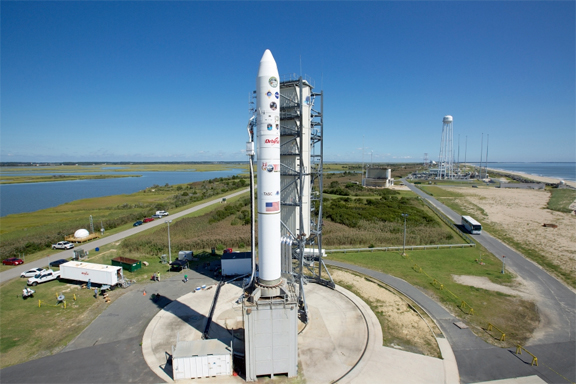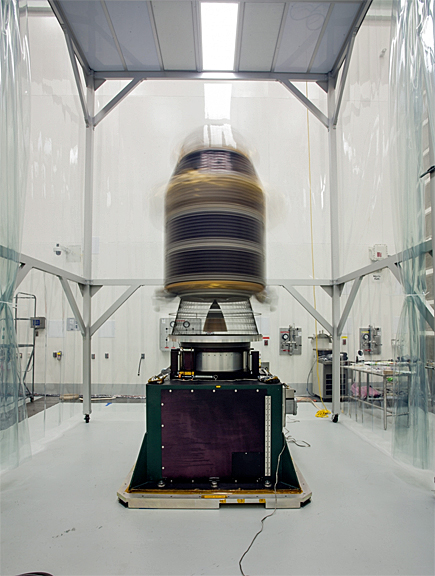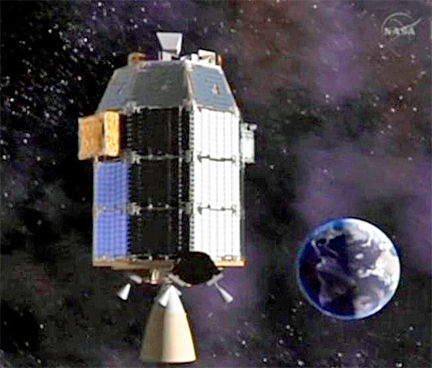
This image shows the Minotaur V rocket that will carry NASA's Lunar Atmosphere and Dust Environment Explorer (LADEE) on a pad at NASA's Wallops Flight Facility at Wallops Island, Virginia.
Photo courtesy of NASA.
The small car-sized Lunar Atmosphere and Dust Environment Explorer (LADEE) is a robotic mission that will orbit the moon to gather detailed information about the structure and composition of the thin lunar atmosphere and determine whether dust is being lofted into the lunar sky. A thorough understanding of these characteristics of our nearest celestial neighbor will help researchers understand other bodies in the solar system, such as large asteroids, Mercury, and the moons of outer planets. LADEE is managed by NASA's Ames Research Center in Moffett Field, California.

Photo of LADEE during its spin test is courtesy of NASA.
Orbital Sciences Corporation (NYSE: ORB) continues its final preparations for the launch of NASA’s Lunar Atmosphere and Dust Environment Explorer (LADEE) spacecraft aboard its new Minotaur V rocket. The vehicle is scheduled to be launched from NASA’s Wallops Flight Facility in eastern Virginia on Friday, September 6, 2013 at approximately 11:27 p.m. EDT. LADEE will mark the first lunar launch from the NASA Wallops facility and Orbital’s first Minotaur rocket launch of a payload that will travel beyond low-Earth orbit.
The Minotaur V is a five-stage space launch vehicle designed, built and operated by Orbital for the U.S. Air Force. It uses three decommissioned Peacekeeper government-supplied booster stages that Orbital combines with commercial motors for the upper two stages to produce a low-cost rocket for launching smaller spacecraft into low-Earth orbit and higher-energy trajectories, such as the trans-lunar flight of the LADEE mission.
“The Minotaur V design builds on Orbital’s proven systems engineering, production, test and flight operations supporting the Minotaur family of rockets, creating another cost-effective launch alternative for U.S. government space missions,” said Mr. Lou Amorosi, Senior Vice President of Orbital’s Small Space Launch Vehicle business. “We look forward to the successful launch of the LADEE orbiter and the opportunity to continue supporting NASA in its exploration and science missions.”
Under the Orbital/Suborbital Program (OSP) contract, which is managed by the U.S. Air Force Space and Missile Systems Center (SMC), Space Development and Test Directorate (SMC/SD) Launch Systems Division (SMC/SDL) located at Kirtland Air Force Base, New Mexico, Orbital designs, integrates, tests and provides launch services to orbit with the Minotaur I, IV, V and VI rockets, as well as other suborbital capabilities with the Minotaur II and III configurations. The company has launched a total of 23 Minotaur rockets with a 100% success record dating back to January 2000.
Employing a combination of U.S. government-supplied rocket motors and Orbital’s proven commercial launch technologies, the Minotaur family of launchers provides reliable and low-cost access to space for government-sponsored payloads. The rockets are specifically designed to be capable of launching from all major U.S. spaceports, including government and commercial launch sites in Alaska, California, Virginia and Florida. Orbital’s use of standardized avionics and subsystems, mature processes and experienced personnel make Minotaur rockets both reliable and cost-effective for U.S. government customers.
In addition to the Minotaur V rocket, the product line includes:
- Minotaur I - The initial member of the Minotaur family, the Minotaur I is a four-stage space launch configuration that can place up to 1,300 lbs. into low-Earth orbit. It was originally launched in January 2000 and has conducted a total of 10 successful launches to date.
- Minotaur II - A three-stage suborbital rocket, the Minotaur II is used as a target vehicle for testing U.S. missile defense systems and related missions. This configuration has performed eight successful launches to date.
- Minotaur III - A three-stage suborbital rocket, Minotaur III can deliver suborbital technology demonstration payloads of up to 6,500 lbs. or serve as a target vehicle for testing U.S. missile defense systems and similar missions.
- Minotaur IV - A heavier-lift four-stage space launch vehicle using retired Peacekeeper rocket motors, the Minotaur IV is capable of launching satellites weighing up to 3,800 lbs. into low-Earth orbit. Five successful launches have been conducted with this configuration.
- Minotaur VI - An evolutionary version of the flight-proven Minotaur IV, the Minotaur VI provides a highly-capable and cost-effective launcher for U.S. Government-sponsored spacecraft of up to 7,000 lbs. into low-Earth orbit. The combination of four government-furnished solid rocket stages, a commercial solid rocket upper stage, and Orbital’s flight-proven systems and processes provide unmatched value and performance.
NASA’s Lunar Atmosphere and Dust Environment Explorer is a robotic mission that will orbit the moon to gather detailed information about the lunar atmosphere, conditions near the surface and environmental influences on lunar dust. A thorough understanding of these characteristics will address long-standing unknowns, and help scientists understand other planetary bodies as well. The LADEE spacecraft’s modular common spacecraft bus is an innovative way of transitioning away from custom designs and toward multi-use designs and assembly-line production, which could drastically reduce the cost of spacecraft development, just as the Ford Model T did for automobiles.
Additional information about LADEE can be found at http://www.nasa.gov/LADEE. Live launch coverage of the LADEE mission will be available at http://www.nasa.gov/multimedia/nasatv/index.html.
During preparations for NASA's Lunar Atmosphere and Dust Environment Explorer (LADEE) observatory launch on September 6, 2013, the spacecraft went through final preparations and close-outs, which included checking alignment after its cross-country shipment, checking the propulsion system for leaks, inspecting and repairing solar panels, and final electrical tests.
After these activities were completed, more challenging portions of the launch preparations began: spin testing and fueling.

Artistic rendition of LADEE is courtesy of NASA.
Engineers from NASA's Ames Research Center in Moffett Field, California, have now successfully completed launch preparation activities for LADEE, which has been encapsulated into the nose-cone of the Minotaur V rocket at NASA's Wallops Flight Facility in Virginia. LADEE is ready to launch when the window opens on Friday.

